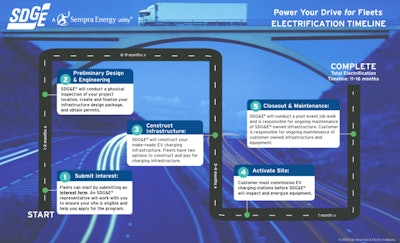
San Diego Gas & Electric (SDG&E) announced today the launch of Power Your Drive for Fleets, the first large-scale program of its kind in the region that will provide charging infrastructure to support the transition to zero-emission buses, trucks, forklifts and other medium- and heavy-duty vehicles and equipment.
At the same time, SDG&E announced its goal to transition its own entire operations fleet – including pickup trucks and bucket trucks – to zero emission vehicles (ZEV) by 2040.
Power Your Drive for Fleets will install charging infrastructure to support a minimum of 300 locations and facilitate the deployment of at least 3,000 medium- and heavy-duty electric vehicles in the San Diego region over the next five years. Organizations interested in this program are urged to visit sdge.com/fleets to learn how they can participate in the program.
“One of the most impactful ways to tackle climate change and air pollution is to reimagine our transportation sector as it is the single largest source of harmful emissions in our region and throughout California,” said Estela de Llanos, SDG&E’s vice president of clean transportation, sustainability and chief environmental officer. “As we support local businesses and organizations to electrify their fleets, it’s important that we live by example and are working simultaneously to transition our own fleet of about 1,700 vehicles to zero-emission vehicles.”
By 2030, SDG&E aims to electrify 100% of its light-duty fleet vehicles and transition 30% of its overall fleet to ZEVs by 2030. And by 2040, the company aims to have a 100% zero-emission fleet. Since 2010, SDG&E has replaced 17% of its fleet with low-emission vehicles.
SDG&E’s Power Your Drive for Fleets program is geared to make it easier and more cost-effective for fleets to install charging infrastructure. Power Your Drive for Fleets connects fleets with reduced electricity pricing plans, financial incentives, and rebates, as well as site design, permitting, construction, activation, maintenance, and upgrade support that can reduce or even eliminate infrastructure costs.
The program also offers additional rebates on charging equipment for schools, transit agencies, and eligible sites located in communities that struggle with socio-economic disadvantages, including air pollution due to proximity to traffic or large commercial/industrial facilities.







